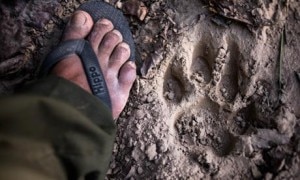The battle to save the tigers in Karnali

KATHMANDU, Nepal-In the foothill of the Himalayas, a war is being waged. Soldiers armed with M16 assault rifle patrol the grasslands and forests while close observation buzzes in the clouds. But they are combating not against any particular army but to save the tiger from extinction – and the enemy is the poachers whose activities are on rampant in the latest days .
The London based Observer accompanied a group of soldiers and rangers on a search mission along the Karnali river in Nepal’s Bardiya National Park. Crocodiles lied in the shallows, while the screeches of monkeys and birds disturbed the heavy, still air. The pugmarks – the paw prints – of an adult tiger were visible in the mud on the bank. A poacher staking out this spot for a couple of days would have a chance of catching one of the cats, as they often return to familiar watering hole, reported the Guardian .
It is estimated that there are 3,200 tigers left worldwide – 95% fewer than a century ago – and the booming wildlife trade is the biggest threat to their survival. Increasing affluence in Asia has caused prices for skins and the body parts used in traditional Chinese medicines to soar.
Anti-poaching work has its dangers. Ramesh Thapa, assistant warden at Bardia, has been targeted: “I got phone calls with death threats and then a middleman came to warn me that a hitman had been hired to kill me – the man knew me so he told me. I moved my wife and daughter from a village to Kathmandu because I was so worried. I live in the park and go everywhere in a group now.”
The Nepal police’s criminal investigation bureau established a wildlife unit just two years ago. Superintendent Pravin Pokharel, 38, led the 11-strong unit responsible for activity outside the nine vast national parks until last August. According to him 15-20% of Nepalese wildlife crime is detected.
The bureau have deployed some spies who disclose them someone is dealing tiger skin or rhino horn and they go secretly as buyers and get evidence using spy recorders and video and go through phone records. Thapa also revealed that one year ago a dealer tried to sell an undercover officer a jute bag of bones from a whole tiger.
“During my time we arrested 100 people, mostly small-time dealers. The big dealers are based in India. They use local tribespeople to kill to order.” Most of the plunder goes to China, he told to Guardian adding the price is mounting all the time.
Thapa also disclosed that two people with one rhino horn were demanding 6m Nepalese rupees (£42,000) in Chitwan three days ago. That would fetch 8m rupees (£56,000) in Kathmandu, and be multiplied in China.”
During the decade long insurgency between the government forces and Maoist rebels from 1996 to 2006, the army checkpoints in the parks had helped curb the wildlife trade were deserted after they became a prime target for the guerrillas.
With the series of conservation and anti-poaching programme launched by WWF, now tiger numbers are inching up. Last year it was estimated that there were 37 in Bardia national park, up from 18 in 2009. In 2010 the WWF launched a multi-million pound global Tigers Alive appeal with the aim of doubling the number by 2022. One of the areas where it is concentrating its efforts is the Terai Arc, 5m hectares which includes Bardia national park on the border with India where around 120 royal Bengal tigers live near three million people.
In the park, there are now 31 anti-poaching bases, and some of the money will be spent on providing more of them with solar power so they can be manned around the clock. The WWF has also started a gun amnesty which has taken in hundreds of homemade guns – the village receives £3.50 for each weapon handed in. Volunteers have been trained how to set up camera-traps so that animals can be monitored.

One of the keys to boosting tiger numbers is to restore their habitat in the “corridors” between the parks. Tigers need to be able to move freely between the parks so they can mate and catch prey. Much of the WWF’s work here is about harnessing the skills and enthusiasm of villagers so they can run anti-poaching patrols and conservation projects themselves.
In 2006, tigers had 40% less habitat than 10 years earlier. Increasing demand by villagers for wood for fuel and building, illegal logging, agricultural expansion and intensive grazing are all behind the erosion. In recent years there has been increasing conflict between tigers and humans as the cats have been forced into populated areas where they kill livestock – leading some farmers to retaliate by poisoning. Occasionally, they have killed people.
Twelve years ago the WWF started plantation and seedling protection programmes as well as micro-financing and insurance schemes to protect against livestock being killed. There are now thousands of community forests which are run by local people. Villagers have also been helped to install biogas, reducing the need for firewood, and grazing is now limited.
Bhadai Tharu, vice-chair of the Community Forest Co-ordination Committee in the Khata corridor, lost an eye when he was attacked by a tiger while patrolling grasslands nine years ago. When asked what happened, he lunges forward, claws the air and lets rip a bellicose roar.
“A tiger jumped on me from a bush at about 1pm. My friends ran off,” quoted Guardian as Tharu, 48, a father of three as saing. Removing his sunglasses – given to him by the actor and wildlife campaigner Leonardo DiCaprio when he visited the area – he reveals the scar where his eye had been.
Fearing for his life, he put all his strength into elbowing the animal. “If I do nothing I would die. I made a loud roaring noise and the tiger ran off. Blood was pouring out of my eye. I was taken to hospital and my eye was only attached by one tiny nerve so it had to be removed. One of my ribs was taken out to reconstruct my face,’ the Guardian further quoted him, “I didn’t have much to do with tiger conservation for two years after, but now if I don’t see a tiger’s paw mark every day I feel something is missing.”
The Observer joined Bhadai and around 20 villagers armed with sticks, mainly women in their teens and 20s, on an anti-poaching patrol in the forest near Gauri. Tharu spotted some disturbed leaves and scattered them with a stick to reveal two iron traps; a large net was found nearby. Bhadai tells how they once caught six Indians. “They had set up traps and were camping in a tent [with] a spear, a knife for skinning a tiger as well as a dog and poison. The poisoned dog would have been used as tiger bait. Three hundred villagers surrounded the tent at dawn while police came. The gang was jailed for five years.”
Harirani Chaudhary, 19, a student on the patrol, said: “Without a forest there’s no life for us. That’s why we conserve the forest and patrol. We must save the tiger, because the tiger is head of everything in the food chain. When we have lots of tigers, it means the habitat is strong enough to support all of us. Tourists will come and our village will improve.”
A few months ago, seven tigers and nine rhino were caught on camera traps in the 3km-long Khata corridor. Chapagain said: “Their appearance shows what is being done is working. Fifteen years ago the Khata corridor was barren land and bad forest and there were no tiger or rhino and only a few elephant.”

